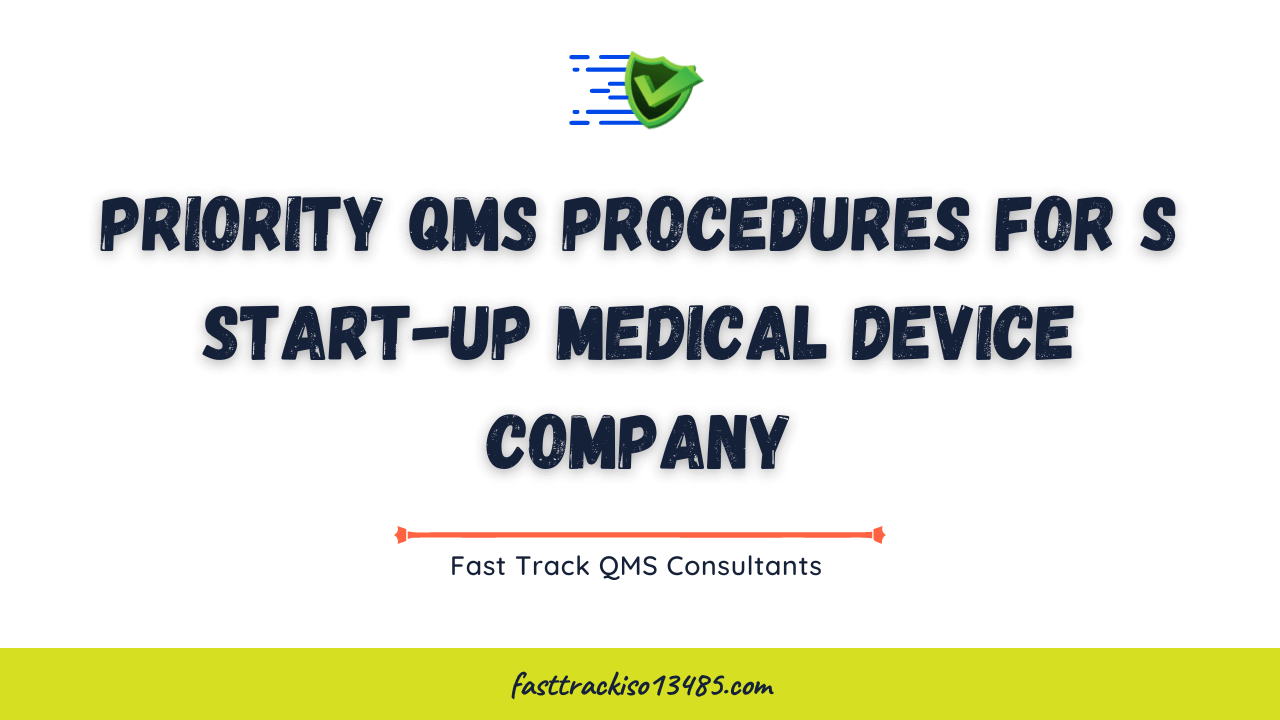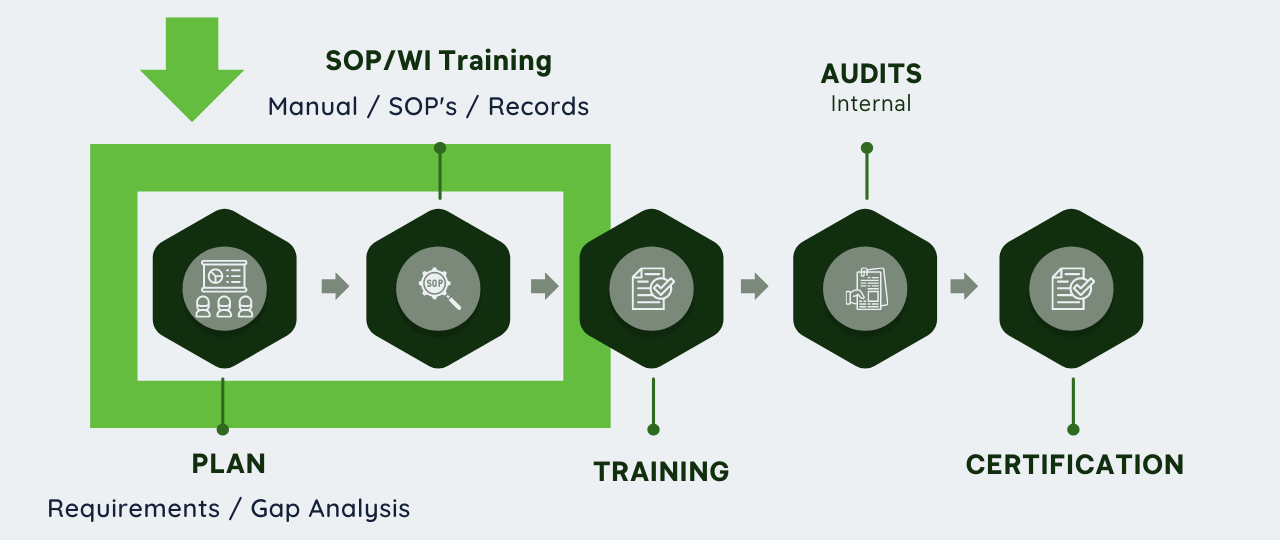
If you?re a start-up medical device company, planning on implementing ISO 13485:2016 and you need to get this done and certification completed as fast as possible so you can start getting a return on your investment, then this article, based on my experience and advise, might help you decide on what documentation you should work on first.
Roughly speaking, a complete quality system for a medical device company and to meet ISO 13485:2016, you will need around 50 standard operating procedures (SOP?s). This will vary depending on your device, manufacturing processes, and markets requiring specific regulatory requirements, i.e. ISO 13485:2016, FDA, European MDR, and others.
Certainly, all the procedures are important, to control your device quality, and will need to be in place, and in use, before you can obtain your ISO 13485 Certification. However if you?re a start-up medical device company and are starting your implementation with zero procedures in place, or a very limited number, you will not be able to write, release, and manage all at the same time.
Even if you obtain templates of the complete SOP set from a consultant similar to the one, we offer at Fast-Track QMS Consultants it will not be practical to implement all at the same time.
Here is an example of priorities; a design and development procedure should be in place as your developing your medical device, where as a management review procedure may not be required until your well into your QMS implementation.
So here in this article I am going to recommend, which SOP?s should be a priority for a start-up medical device company to focus on implementing first, as part of your planning and documentation steps.
????????
??????????????????
So here are my 7 recommended procedures to prioritize for implementation:
Design and Development:
It is not unusual for start-up medical device companies to already have started designing their device and making early prototypes well before planning the implementation of their ISO 3485:2016 quality system. This is ok as long as these first prototypes are pure R&D devices and will not be marketed and sold as finished units to customers.
Once the formal quality system implementation is started however the Design and Development procedure needs to be one of the very first to be released and used to developed the finished design and ready for production and launch.
Documentation of user needs, design inputs, design process, design outputs, risk assessment, design reviews, design validation and design transfer, are all required parts of the design and development procedure.
Requirements detailed in ISO 13485:2016 7.3 Design and development, and FDA 21 CFR Part 820.30 Design controls
Device Master Record:
A procedure for a device master record is required by the FDA, or as called for in ISO 13485:2016, design and development files. This documentation along with the design and development process and procedure needs to be available as you are working through your medical device design project. You also need to be completing records and placing in your Device Master File (DMR) as your project progresses.
Requirements detailed in ISO 13485:2016 7.3.10 Design and development files, as well as 4.2.3 Medical device file, and FDA 21 CFR Part 820.181 Device master record.
Training:
There is nothing in the regulatory requirements that specifies when you need to start training, and so it can be tempting to only to comply sometime before the certification audits. This is not however best practice and can cost you more time and headaches later if you take this approach. I truly believe, and recommend having a training procedure in place and conducting the appropriate training early on, is the right way to go.
Requirements detailed in ISO 13485:2016 6.2 Human resources, and FDA 21 CFR Part 820.25 Personnel
Document System:
Procedures are a fundamental and required part of your quality management system, so having a procedure in place right from the start of your implementation that describe your QMS documentation requirements, including control of documents and records is a clear priority.
This includes training on this procedure for all that are involved with creating and using your QMS documents.
Requirements detailed in ISO 13485:2016 4.2 Documentation requirements, and FDA 21 CFR Part 820.20(e) Quality system procedures, and 820.40 Document Controls.
Process Validation:
As your medical device design becomes finalized the manufacturing processes will need to be ready for production, so therefore your validation procedure needs to be a priority for implementation. In some cases selected manufacturing equipment can be purchased and installed even before the design of the medical device is complete. To stay on your fast-track plan you should be conducting where you can, simultaneous product development and partial process validations.
If the design changes you can always revalidate if required.
Requirements detailed in ISO 13485:2016 7.5.6 Validation of processes for production and service provision, and FDA 21 CFR Part 820.75 Process validation.
Risk Management:
Risk Management is not only a regulatory requirement but also a key element of the design and development process. Risk management should begin during the planning and development phases of device development and continue throughout device design and product life cycle.
ISO:13485:2016 requires risk management and it?s an integral part of several of these other priority procedures I?m recommending to be implemented early.
Requirements throughout the ISO 13485:2016 Standard, and details in ISO 14971:2019. Also in FDA 21 CFR Part 820.30(c) Design input, and 30(g) Design validation.
Supplier Approval:
As your start-up business progresses, and you are ready to go into production and start to order production raw materials from suppliers, you will need to be following a documented Purchasing and Supplier Approval procedure. All raw material/component suppliers, as well as contactors, need to go through an approval process, and be added to an approved supplier list prior to ordering production materials.
The quality of your finished medical device depends largely on the quality of purchased raw materials. Also given that lead times for some suppliers can be significant, it makes sense to give this procedure priority.
Requirements detailed in ISO 13485:2016 7.4.1 Purchasing process, and FDA 21 CFR Part 820.50 Purchasing Controls
Summary of procedures to implement first, and how we can help at Fast-Track QMS Consultants:
Top 7 procedures to implement first:
- Design and Development
- Device Master Record
- Training
- Document System
- Process Validation
- Risk Management
- Supplier Approval
This is just meant to be general guidance and all the required procedures are important and necessary to complete your quality management system. Some may argue, as an example, that, the formal training procedure can come later and after the Management Responsibility procedure, and that?s fine.
Training can start without the formal release of a training procedure, i.e. ISO 13485:2016 Standard awareness training for senior management. However this is still a good SOP to get done among the first ones implemented and facilitate training records and overall training requirements documented for use throughout the QMS implementation.
These are just my thoughts based on experience and would welcome any feedback?.
?How can Fast-Track Consultants help:
The 7 procedures discussed in this article are available as part of our Turnkey Quality System bundle. This bundle includes a total of 50 procedures covering all the elements of ISO 13485:2016, plus the forms that support these SOP?s.
We can certainly also help you customize and release these 7 priority procedures quickly, including any training for your team as required.
If you would like to learn more about Fast-Track QMS Consultants and the products and services, we can offer to a start-up medical device company, just hit the link below and check out our website.
???????????????????????You can also take a look at these articles to further guide you in your QMS Implementation Journey:
How to Fast-Track your Plan for ISO 13485:2016 Certification
Complete Guide how to Fast-Track your ISO 13485:2016 Implementation

The Turnkey Quality System bundle includes:
- Quality Manual template and supporting documents
- 50 Procedures covering all elements of ISO 13485:2016, plus FDA 21 CFR 820 and MDR
- 41 Forms that support the procedures
- 10 -hours of on-line consultation at no charge
More detailed information HERE


